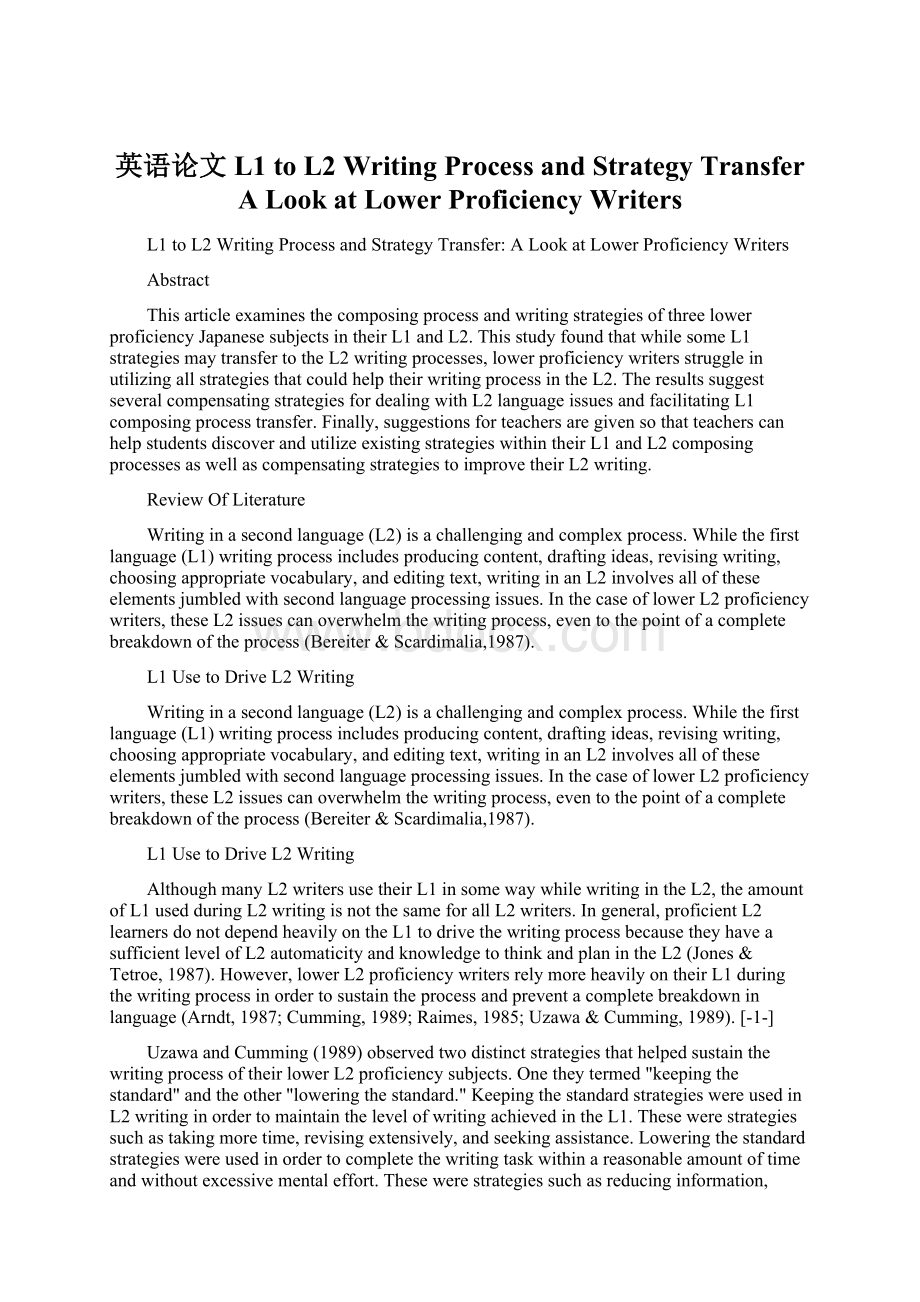英语论文L1 to L2 Writing Process and Strategy Transfer A Look at Lower Proficiency WritersWord格式.docx
《英语论文L1 to L2 Writing Process and Strategy Transfer A Look at Lower Proficiency WritersWord格式.docx》由会员分享,可在线阅读,更多相关《英语论文L1 to L2 Writing Process and Strategy Transfer A Look at Lower Proficiency WritersWord格式.docx(11页珍藏版)》请在冰豆网上搜索。

ReviewOfLiterature
Writinginasecondlanguage(L2)isachallengingandcomplexprocess.Whilethefirstlanguage(L1)writingprocessincludesproducingcontent,draftingideas,revisingwriting,choosingappropriatevocabulary,andeditingtext,writinginanL2involvesalloftheseelementsjumbledwithsecondlanguageprocessingissues.InthecaseoflowerL2proficiencywriters,theseL2issuescanoverwhelmthewritingprocess,eventothepointofacompletebreakdownoftheprocess(Bereiter&
Scardimalia,1987).
L1UsetoDriveL2Writing
AlthoughmanyL2writersusetheirL1insomewaywhilewritingintheL2,theamountofL1usedduringL2writingisnotthesameforallL2writers.Ingeneral,proficientL2learnersdonotdependheavilyontheL1todrivethewritingprocessbecausetheyhaveasufficientlevelofL2automaticityandknowledgetothinkandplanintheL2(Jones&
Tetroe,1987).However,lowerL2proficiencywritersrelymoreheavilyontheirL1duringthewritingprocessinordertosustaintheprocessandpreventacompletebreakdowninlanguage(Arndt,1987;
Cumming,1989;
Raimes,1985;
Uzawa&
Cumming,1989).[-1-]
UzawaandCumming(1989)observedtwodistinctstrategiesthathelpedsustainthewritingprocessoftheirlowerL2proficiencysubjects.Onetheytermed"
keepingthestandard"
andtheother"
loweringthestandard."
KeepingthestandardstrategieswereusedinL2writinginordertomaintainthelevelofwritingachievedintheL1.Thesewerestrategiessuchastakingmoretime,revisingextensively,andseekingassistance.Loweringthestandardstrategieswereusedinordertocompletethewritingtaskwithinareasonableamountoftimeandwithoutexcessivementaleffort.Thesewerestrategiessuchasreducinginformation,simplifyingsyntax,substitutinglexicalitems,andignoringreaderconcerns.ThesubjectsinthestudyproducedL2papersthathadlesscontentthantheirL1writing,butaboutequalqualitytotheirL1writing.Overall,theL1aidedinkeepingthestandard.IftheL1wasnotused,wecansurmisethatthequalityofwritingwouldhavebeenlowerthanitwasandthestandardwouldhavehadnochecksandbalancesinplacetokeepitonahigherplane.
SeveralstudieshavelookedattheeffectofcomposingintheL1andthentranslatingintotheL2(Cohen&
Brooks-Carson,2001;
Kobayashi&
Rinnert,1994).ThesestudieshavefoundthatthelowerL2proficiencywritersbenefitedfromcomposingintheL1andthentranslatingintotheL2,aresultthathighlightstheimportanceofusingL1composingstrategiesforlowerL2proficiencywriters.
JonesandTetroe(1987)didastudyontheeffectofL1useduringL2writing.TheyfoundthatthelowerL2proficiencywriterswhodidnotusetheirL1werelesseffectiveintheirplanning.ThewriterswhodidusetheirL1producedmoredetailsduringtheplanningstageofL2writing.Furthermore,theL1facilitatedmoreabstractthoughtduringplanning.
ResearchQuestion
AlthoughwehavesomeunderstandingofhowlowerproficiencywriterscopewiththedemandsofwritinginanL2,ourpictureisstillincomplete.OneareainwhichwestillhavelittleunderstandingisthedegreetowhichL2writerstransfertheirL1composingprocessandstrategiestotheirL2writing.WhileitisgiventhatL2writingposeschallengesthatareuniquefromL1writingandthusrequireuniquestrategiestodealwith,itisreasonabletoassumethatpartsofthecomposingprocessaresimilaroreventhesameintheL1andtheL2.ThepurposeofthisstudyistoinvestigatethedegreetowhichlowerL2proficiencywriterstransfertheircomposingprocessesandstrategiesfromL1writingtoL2writing.Thequestionthatthisresearchsoughttoansweris:
WhatL1composingprocessesandstrategiesdolowerL2proficiencywriterstransfertoL2writing?
Method
Subjects
ThreenativeJapanese-speakingsubjectswereselectedfromanintensiveEnglishprogramintheU.S.toparticipateinthisresearch.TheywerechosenfortheirbeginningEnglishproficiency,theirwiderexperiencewithwritinginJapanese,andtheirlimitedexperiencewithwritinginEnglish.Allthreesubjectswerefemaleandtheiragesrangedfrom26to28yearsold.Allthreesubjectswerehighschoolgraduates,andtwoofthethreesubjectshadalsograduatedfrom2-yearcolleges.[-2-]
Procedure
Sixthink-aloudprotocolswerecollectedwhilethesubjectscomposedessaysinJapaneseandtheninEnglish.Eachsubjectindividuallyparticipatedintwocomposingsessionsinwhichthesubjectwroteanessaywhilethinkingaloud.InthefirstsessionsubjectswroteaJapaneseessayandinthesecondsessiontheywroteanEnglishessay.Thesessionswerevideoandaudiotapedforsubsequenttranscription,analysis,andcomparison.
Eachsessionfollowedasimilarpattern.Firsttheresearcherexplainedthepurposeofthink-aloudprotocolsandgaveabriefdemonstrationoftheprocessbycomposingthefirstparagraphofanessaywhilethinkingaloud.Thesubjectthenpracticedtheprotocolmethodwhiletheresearchercheckedforqualityandsubjectunderstandingoftheprocess.Subjectswerethengivenanessaytopic(seeTable1).BothessaytopicscamefromthetestbankofTOEFLessaytopics.
JapaneseEssayTopic
EnglishEssayTopic
Whenpeopleneedtocomplainaboutaproductorpoorservice,someprefertocomplaininwritingandothersprefertocomplaininperson.Whichwaydoyouprefer?
Usespecificreasonsandexamplestosupportyouranswer.
Whenpeoplemovetoanothercountry,someofthemdecidetofollowthecustomsofthenewcountry.Othersprefertokeeptheirowncustoms.Whichonedoyouprefer?
Supportyouranswerwithspecificdetails.
Table1—EssayTopics
ThetopicfortheJapaneseessaywaswritteninJapaneseandthetopicfortheEnglishessaywaswritteninbothJapaneseandEnglish.Thesubjectbegantheprotocolbyreadingthetopicaloud.Thesubjectwasallowedtotakeasmuchtimeastheyneededtocomposetheiressayandtheysignaledtheresearcherwhentheyfinishedcomposing.
Results
Twoprotocolsforeachofthethreesubjectswerecollected,transcribedandthenreviewedandanalyzedforcomposingprocessesandstrategies.Thedescriptionsbelowhighlightthemainfeaturesofeachsubject'
sJapaneseandEnglishessaycomposingprocessandstrategies.Theyalsocompareandcontrastthoseprocessesandstrategiesforsimilaritiesanddifferences.
Katsue
TheformatandlengthofKatsue'
sprewritingvariedbetweenthetwoessays.DuringtheJapaneseessay,Katsuespent8minutesmakingalistofideasundertwoseparateheadingsbeforebeginningtodraftheressay.Theideaswereembodiedinavarietyofwords,phrases,andsentencesundereachheading.TheideagenerationfortheEnglishessaytook18minutesandlookedmorelikeafirstdraftwithoutanyorganization.
Despitetheidenticalstructureofthetwoessaytopics,therewerenoheadingstoidentifythetwooptionsinherEnglishessayprewritingastherehadbeeninherJapanese.KatsuewrotedownherideascompletelyinEnglishasshebrainstormedinJapanese.SimilartoherJapaneseprewriting,sheusedamixtureofwords,phrases,andsentencestowritedownherideas;
however,unlikeherJapaneseprewriting,Katsuedidnotuseanevenbalanceofallthreebutusedmostlycompletesentences.PartofherideagenerationforherEnglishessaywasfindingtheEnglishthatbestexpressedherideas.ThiswasevidencedbythenumerousrevisionsmadetothesesentencesbeforeKatsuebegancomposingheressay.[-3-]
WhilecomposingherJapaneseessay,therewerethreetriggersthatcausedhercomposingprocesstocyclefromwritingintovariouscombinationsofrehearsingideas,revising,editing,andreading.Thesetriggerswerecompletingasentence,searchingforawordtomoreclearlyexpressanidea,andnotknowinghowtocompleteathought.
Aftercompletingasentence,Katsuewouldusuallyrereadwhatshehadjustwritten,sometimesevaluatingitbeforecontinuingonwiththenextsentence.Forexample,Katsuefinishedcomposingthesentence,"
WhenIthinkaboutit,Iabandonmycomplainthalfwaythrough"
(seeAppendixA).Whenshecompletedthesentence,Katsuewentbackandrereadit,givingheranewideathatpushedhertowritethenextsentence,"
ThisisbecauseeventhoughIthinkitinmyheart,itisverydifficultformet